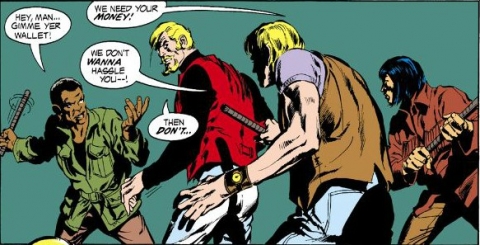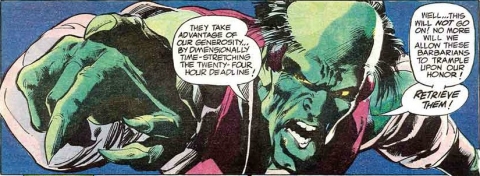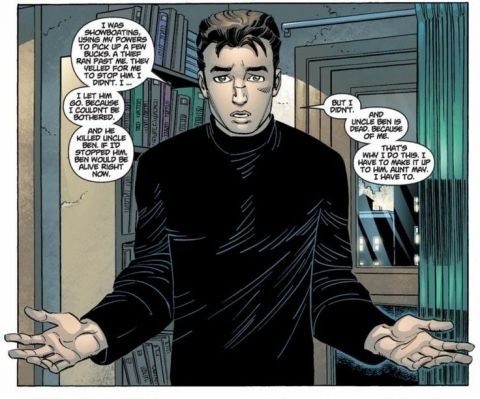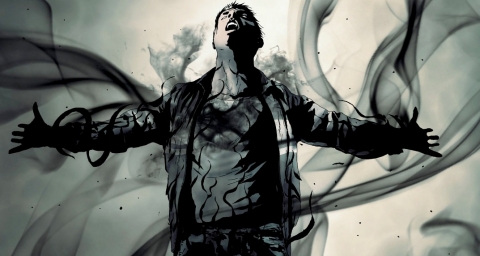52 weeks. 52 different writers. 2 trade paperbacks or hardcovers a week. Each week I’ll take a look at a different writer and read two different collected editions from within that person’s repertoire to help in the examination of their work.
Denny O’Neil began his career in comics thanks to some spare time on a Tuesday afternoon. When comics legend Roy Thomas jumped over to Marvel Comics, he suggested that O’Neil take their writers test, which entailed writing dialogue for four pages of a Fantastic Four comic. Stan Lee was impressed enough with O’Neil’s work that he was hired on to write a few comics, ranging for Daredevil to Doctor Strange. From there O’Neil would go on to work for Charlton Comics before making his way over to DC Comics where he would help to bolster sales on a few books as well as make controversial changes to key characters like Wonder Woman. It 1970, O’Neil would team with Neal Adams to tell socially and politically charged stories in the short-lived “Green Lantern/Green Arrow”, bringing forth a level of real world awareness unseen in comics at the time. Together the two men would craft the most famous Green Arrow story ever in Green Lantern #85-86, in which it is revealed that Green Arrow’s ward, Speedy, is addicted to heroin.
Green Lantern/Green Arrow
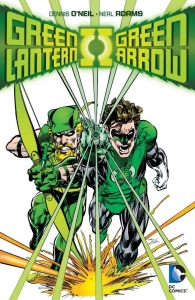 Hal Jordan, otherwise known as the Green Lantern of Earth, is confronted with the real world consequences of being out of touch with the state of his own world, being seen as a man who doesn’t care enough about the affairs of other races or communities. The truth of this realization is harrowing and realized through an assist by Hal’s dear friend, Oliver Queen, otherwise known as the snappy hero, Green Arrow. Together the two men travel the countryside of America with the hopes of learning more about the planet they risk their lives to protect. With the addition of a Guardian from Oa, the same group of aliens who gave Green Lantern his power, the two men and their new ally learn a multitude of life lessons from a wide variety of diverse people. From neglected African Americans, to rebellious civil riots, to a lack of respect for Native American values, Green Lantern and Green Arrow experience life through a whole new set of eyes, discovering as much about themselves as they do about the world.
Hal Jordan, otherwise known as the Green Lantern of Earth, is confronted with the real world consequences of being out of touch with the state of his own world, being seen as a man who doesn’t care enough about the affairs of other races or communities. The truth of this realization is harrowing and realized through an assist by Hal’s dear friend, Oliver Queen, otherwise known as the snappy hero, Green Arrow. Together the two men travel the countryside of America with the hopes of learning more about the planet they risk their lives to protect. With the addition of a Guardian from Oa, the same group of aliens who gave Green Lantern his power, the two men and their new ally learn a multitude of life lessons from a wide variety of diverse people. From neglected African Americans, to rebellious civil riots, to a lack of respect for Native American values, Green Lantern and Green Arrow experience life through a whole new set of eyes, discovering as much about themselves as they do about the world.
Denny O’Neil and Neil Adams did amazing, socially aware work with their run on Green Lantern back in the ’70’s, now collected in a massive paperback format known as “Green Lantern/Green Arrow”. The Green Lantern/Green Arrow mashup from these two legendary creators is one that, at first glance to some, might only seem cool because they managed to get two heroes with the word “Green” in their name to start teaming up but when you actually take the time to read these tales and see what they set out to accomplish, you’ll realize just how important of a comic book crossover this really was. O’Neil and Adams took two good friends and pitted their very ideologies against each other, with Green Arrow’s liberal views starkly contrasting that of the conservative Green Lantern. It set the characters on a collision course from the opening pages of the crossover and more often than not put them at odds with each other repeatedly, only to then have them unite to fight greater injustices than their own clashing egos.
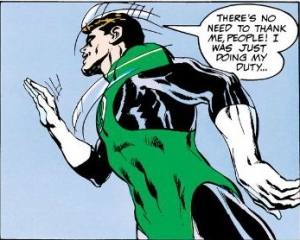 The most compelling aspect of this crossover is definitely the lead character views in conjunction with the conflicts they face. Seldom are they up against an intergalactic foe, instead battling real world problems like greed, misconduct, environmental threats, drug use, racism and prejudice, as well as so much more. The wackiest types of stories you’ll find in the midst of these two intersecting heroes are plots like a young girl with powers capable of crippling anyone she chooses with a single thought or the Black Hand brainwashing a town of innocent patrons. Beyond stories like those ones, O’Neil and Adams do their absolute best to ground out the story in a way that tackles serious issues that felt important for the time period. Nowadays, readers might look at the stories as “goofy” or “cheesy”, and to an extent they are, but they still take advantage of an entertainment medium to help educate readers of actual issues that we face as humans, something that nearly every comic being published in today’s market lacks. From the opening pages that imply Green Lantern is mildly racist for never thinking about black people, to Oliver Queen’s sidekick Speedy’s heroin addiction, to even the introduction of John Stewart (one of the most important black superheroes in existence), make no mistake that underneath the old school appearance of these stories that there is plenty at work and much of it is still applicable today.
The most compelling aspect of this crossover is definitely the lead character views in conjunction with the conflicts they face. Seldom are they up against an intergalactic foe, instead battling real world problems like greed, misconduct, environmental threats, drug use, racism and prejudice, as well as so much more. The wackiest types of stories you’ll find in the midst of these two intersecting heroes are plots like a young girl with powers capable of crippling anyone she chooses with a single thought or the Black Hand brainwashing a town of innocent patrons. Beyond stories like those ones, O’Neil and Adams do their absolute best to ground out the story in a way that tackles serious issues that felt important for the time period. Nowadays, readers might look at the stories as “goofy” or “cheesy”, and to an extent they are, but they still take advantage of an entertainment medium to help educate readers of actual issues that we face as humans, something that nearly every comic being published in today’s market lacks. From the opening pages that imply Green Lantern is mildly racist for never thinking about black people, to Oliver Queen’s sidekick Speedy’s heroin addiction, to even the introduction of John Stewart (one of the most important black superheroes in existence), make no mistake that underneath the old school appearance of these stories that there is plenty at work and much of it is still applicable today.
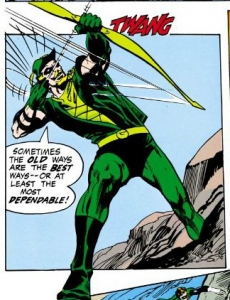 The character portrayals are something of an interesting stance with this story as Green Arrow is arguably portrayed in a better light than the actual lead character of the title, Green Lantern. O’Neil and Adams make Green Arrow a shining example of a man multiple times throughout the story while actually chopping away at everything Green Lantern knows and believes in. Within one issue the reader begins to see a creeping sense of doubt that looms over Hal Jordan, being forced to reassess the oath he swears as Green Lantern because of all the things he remains uninformed about on Earth. Where Hal Jordan is a feeble, poorly informed man, Oliver Queen is a knowledgable, “for the people”, Robin Hood-esque champion who only wants the best for the lessfortunate. By today’s standards, Green Arrow is the Justin Trudeau of the world while Green Lantern is Stephen Harper…even if you’re not a Canadian you should get what I’m saying. That’s not to say that Green Arrow is a perfect man, as O’Neil and Adams take plenty of opportunities to actually portray him as imperfect, giving Green Lantern a few notches in his belt throughout the story as well. The characters nearly always have conflicting views on the problems at hand, with Green Arrow taking what is typically the more politically correct stance while Green Lantern stands loosely opposed to it before being swayed by Arrow’s argument or just the events that are transpiring around him. Even when Green Arrow is proven as irrational or wrong, he still somehow always manages to come out looking like the more correct of the two heroes, with the issue wherein a man of “nature” is sabotaging Ferris Airway to help protect the environment being an excellent example of what I’m saying. Green Arrow begins to support this mystery man because he agrees with his views, with no rationale other than he likes what the man stands for. He blindly defends the man and even attacks Green Lantern while trying to do so, which sets him at odds with not only the mystery man for an action he takes against Green Lantern but Green Lantern himself as well. By issues end, Arrow still agrees with the man and tries to fight for him with Lantern becoming guilty by association. When something terrible happens to the man, Lantern, even though he never supported this man’s beliefs, immediately vents his frustrations by destroying one of the Ferris jets, a poignant gesture against the harm they do to the climate but also hammering home the idea that even when Green Arrow is wrong, he’s right and Lantern takes the most away from the situation.
The character portrayals are something of an interesting stance with this story as Green Arrow is arguably portrayed in a better light than the actual lead character of the title, Green Lantern. O’Neil and Adams make Green Arrow a shining example of a man multiple times throughout the story while actually chopping away at everything Green Lantern knows and believes in. Within one issue the reader begins to see a creeping sense of doubt that looms over Hal Jordan, being forced to reassess the oath he swears as Green Lantern because of all the things he remains uninformed about on Earth. Where Hal Jordan is a feeble, poorly informed man, Oliver Queen is a knowledgable, “for the people”, Robin Hood-esque champion who only wants the best for the lessfortunate. By today’s standards, Green Arrow is the Justin Trudeau of the world while Green Lantern is Stephen Harper…even if you’re not a Canadian you should get what I’m saying. That’s not to say that Green Arrow is a perfect man, as O’Neil and Adams take plenty of opportunities to actually portray him as imperfect, giving Green Lantern a few notches in his belt throughout the story as well. The characters nearly always have conflicting views on the problems at hand, with Green Arrow taking what is typically the more politically correct stance while Green Lantern stands loosely opposed to it before being swayed by Arrow’s argument or just the events that are transpiring around him. Even when Green Arrow is proven as irrational or wrong, he still somehow always manages to come out looking like the more correct of the two heroes, with the issue wherein a man of “nature” is sabotaging Ferris Airway to help protect the environment being an excellent example of what I’m saying. Green Arrow begins to support this mystery man because he agrees with his views, with no rationale other than he likes what the man stands for. He blindly defends the man and even attacks Green Lantern while trying to do so, which sets him at odds with not only the mystery man for an action he takes against Green Lantern but Green Lantern himself as well. By issues end, Arrow still agrees with the man and tries to fight for him with Lantern becoming guilty by association. When something terrible happens to the man, Lantern, even though he never supported this man’s beliefs, immediately vents his frustrations by destroying one of the Ferris jets, a poignant gesture against the harm they do to the climate but also hammering home the idea that even when Green Arrow is wrong, he’s right and Lantern takes the most away from the situation.
To further elaborate on how great Green Arrow comes across in a story that should be a Green Lantern story first and a Green Arrow one second, he also steals the show with the two-parter “Snowbirds Don’t Fly”, dealing with the drug addiction of his sidekick, Speedy. Up until that point, the stories that O’Neil and Adams told dealt almost specifically with repressed minorities, racism, and prejudice. As a reader you always got two opposing views from the two wildly different heroes but with this story, Green Arrow hogs the spotlight in dealing with an incredibly personal matter that is relevant to anyone regardless of their skin colour or gender. The heartbreaking two-parter is a message to the youth of the world of the dangers of using drugs, with their highly addictive nature being dangerous to anyone at any time, even superheroes. Green Arrow is nearly fatally injured by a young heroin addict and teams up with Green Lantern in an attempt to try to stop this current heroin ring. The two heroes are trapped and actually forced to take the drugs, with Speedy narrowly saving the heroes. O’Neil and Adams demonstrate the sick nature of a drug addiction throughout the scene where Lantern and Arrow are high through the imagery associated with Lantern attempting to use his ring to get the heroes to safety. When Lantern attempts to use his ring, he sees a monstrous, distorted image of himself that attempts to attack him before being saved by Speedy. From there, the heroes move along to the revelation that Speedy is a heroine addict himself, with the pressures of being a hero along with mounting loneliness being a leading reason for the new addiction. It’s a dark truth that falls largely on Arrow’s shoulders for abandoning his ward when he needed him most, isolating the idea that you can always help someone who is a struggling drug addict. This two-parter highlights the socially aware take that O’Neil and Adams took with these characters decades ago, with the lessons they tried to teach still ringing true to this very day.
Collects: Green Lantern #76-87, 89 and Back up stories from The Flash #217-219, 226
Best Character: Green Arrow
Best Line Of Dialogue/Caption: “Who else did you think I was talking about?” – Speedy
Best Scene/Moment: Speedy shows Oliver how he really feels – Issue 86
Best Issue: Issues 85-86. I already did a brief paragraph highlighting the brilliance of this two parter but it stands true that these are the best issues in the volume. They’re iconic and meaningful in a way that is relatable to anyone regardless of their skin colour, nationality, or gender. The book is drawn beautifully by Neal Adams with Denny O’Neil providing a fluid barrage of words that keep the gears moving but still provides a harsh sting of truth for the reader.
Why You Should Read It: I know people complain that “I can’t read old comics because the art sucks!” or “I hate old comics because the stories aren’t as exciting!” and to that I say hogwash. Some of the greatest comics ever are from this time period and it is all a matter of acquired taste. Speaking personally, I was a man who struggled to enjoy older comics until I understood how to read them. These aren’t stories that are meant to be devoured in two to five minutes, but they are meant to actually be READ. It’s supposed to take you 25-30 minutes to read just a single issues because these books were created during a time where comics were meant to captivate their audience for a longer period of time, instead of briefly holding our interest for today’s attention lacking generation. The importance of stories like Green Lantern/Green Arrow (a.k.a. “The Hard Travelling Heroes”) is unparalleled and anyone who disagrees just simply doesn’t get it. Maybe reading this post will help them or maybe it won’t, all I know is that of all the graphic novels I’ve done for the challenge thus far, this is one story you have to read before you die.
Superman vs. Muhammad Ali
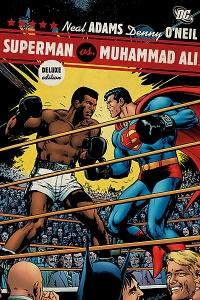 Longtime collaborators Denny O’Neil and Neal Adams have worked on so many titles together that it’s almost hard to keep track of them all. One of the earliest collaborations between the two men was actually for Marvel Comics, resurrecting Charles Xavier in X-Men #65. From there they moved over to DC Comics, working on titles like Green Lantern, Batman, and Superman vs. Muhammad Ali. O’Neil widely regards Superman vs. Muhammad Ali as one of his favourite collaborations with Neal Adams, giving us another celebrity style team-up for everyone’s favourite Man Of Steel!
Longtime collaborators Denny O’Neil and Neal Adams have worked on so many titles together that it’s almost hard to keep track of them all. One of the earliest collaborations between the two men was actually for Marvel Comics, resurrecting Charles Xavier in X-Men #65. From there they moved over to DC Comics, working on titles like Green Lantern, Batman, and Superman vs. Muhammad Ali. O’Neil widely regards Superman vs. Muhammad Ali as one of his favourite collaborations with Neal Adams, giving us another celebrity style team-up for everyone’s favourite Man Of Steel!
Standing in the red corner, is a man often referred to as “The Man Of Steel”. Brandishing less than traditional ring wear, with a pair of tights that look like he’s wearing underwear over top of them along with a red cape draped over his shoulders, he is humanity’s one, true hope. He is faster than a speeding bullet, more powerful than a locomotive, and able to leap tall buildings in a single bound. He is the one and only, Superman! In the blue corner, he is the greatest heavyweight boxer of all time. In his iconic white shorts, a towering mass of a man as powerful as an ox but as fast as a cheetah, he floats like a butterfly and stings like a bee! If you ever dream of beating him, you’d better wake up and apologize because he is none other than Muhammad Ali! In a showdown for the ages, Superman and Muhammad Ali must face each other down to decide who’s Earth’s greatest champion is. This match will decide who will take on the chosen champion of an invading alien race with the fate of the entire world hanging in the balance. When an unstoppable force collides with an immovable object, there is no telling what may occur as the two men duke it out, holding nothing back in deciding who is the greatest of all time and fit enough to defend the Earth.
Neal Adams and Denny O’Neil give you the crossover you never knew you wanted with Superman vs. Muhammad Ali. This one-of-a-kind story perfectly encapsulates the beauty of the sequential art form, bringing the stories that readers could only dream off to life with this magnificent story. The two iconic creators take two of the most iconic pop culture figures of this century and throw them together, full steam ahead in a story that is cheesy, ridiculous, over-the-top, but most importantly, fun. In a simple series of words, it’s easy to point out that this isn’t the greatest comic book story ever created but it’s again worth noting that this story is one of the best examples of why comics are so much fun to begin with.
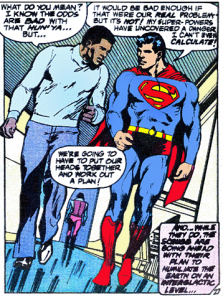 From the top we have to look at the plot and accept it for what it really is: a paper-thin tale that is meant to get Superman and Muhammad Ali in the same panels as one another. There’s no complexity to the narrative, although Adams and O’Neil do try their best to throw at least one unexpected swerve the reader’s way before the end of the story. It’s Silver Age in the finest of ways even if this is technically a Bronze Age comic, embracing the campy nature of what is trying to be done to the fullest to tell a story with kind intentions and a great amount of heart. It all starts simply, with the crew from the Daily Planet trolling the streets for a hot new scoop when they encounter the champ himself out on the street with some children playing basketball. The sudden appearance of a mysterious alien draws Clark Kent to quickly change into his alter ego, Superman, to try to remedy the potentially chaotic situation. Before long, the alien demonstrates that its race could do whatever it wants to Earth with their weapons, placing a proverbial gun to our planet’s head. The invader demands that the Earth’s champion face a champion of their own for the fate of the planet, with Superman and Ali immediately torn between which one of them should defend their planet, feeling as though they are both the “greatest ever”. Through some trickery, the two men condense weeks of training into mere hours and face off to determine who will fight for the Earth’s survival. The story does have a clear act structure, from which it benefits but, like I said earlier, this isn’t a story that would be winning awards nowadays. Everything serves a purpose here though and the plot fulfills the need to have the two heroes from Earth jump from witty banter, to punching each other before ultimately saving the planet.
From the top we have to look at the plot and accept it for what it really is: a paper-thin tale that is meant to get Superman and Muhammad Ali in the same panels as one another. There’s no complexity to the narrative, although Adams and O’Neil do try their best to throw at least one unexpected swerve the reader’s way before the end of the story. It’s Silver Age in the finest of ways even if this is technically a Bronze Age comic, embracing the campy nature of what is trying to be done to the fullest to tell a story with kind intentions and a great amount of heart. It all starts simply, with the crew from the Daily Planet trolling the streets for a hot new scoop when they encounter the champ himself out on the street with some children playing basketball. The sudden appearance of a mysterious alien draws Clark Kent to quickly change into his alter ego, Superman, to try to remedy the potentially chaotic situation. Before long, the alien demonstrates that its race could do whatever it wants to Earth with their weapons, placing a proverbial gun to our planet’s head. The invader demands that the Earth’s champion face a champion of their own for the fate of the planet, with Superman and Ali immediately torn between which one of them should defend their planet, feeling as though they are both the “greatest ever”. Through some trickery, the two men condense weeks of training into mere hours and face off to determine who will fight for the Earth’s survival. The story does have a clear act structure, from which it benefits but, like I said earlier, this isn’t a story that would be winning awards nowadays. Everything serves a purpose here though and the plot fulfills the need to have the two heroes from Earth jump from witty banter, to punching each other before ultimately saving the planet.
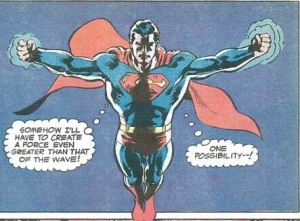 The plot most certainly won’t be the reason you trooper through all the pages of this comic. The redeeming quality of this unique crossover is without a doubt the star power of the two characters it features. O’Neil and Adams cast Superman and Muhammad Ali perfectly, showing a great grasp on both of the brave, powerful men. It seems that at any story juncture, the two creators take any opportunity to highlight what makes these men so unique, as well as woefully important to the story. With Superman, it’s perfectly characterized from the conversation he has with Muhammad Ali early on in trying to decide who should fight for Earth. The obvious answer to some is Ali simply because Superman is an alien himself, not originally from our world but instead adopted amongst our people. Superman at his core is a character who is meant to highlight the acceptance and diversity of the human race, being this magnificent being who is still humbled to live amongst those who are significantly weaker than him. That’s why he bares the name Superman instead of “Super-alien”, because as far as he’s concerned, he is just a man with exceptional abilities, even if he has an alien physiology. This is the argument he makes for representing a planet that has become as much of a home planet to him as it is to the very people born upon it. O’Neil and Adams also capture the undying spirit of Superman when he fights Ali to decide who will fight the aliens to save their world. Rocked by numerous punches, Superman absorbs punishment without rest, never wavering as he eats shot after shot, refusing to succumb to the pain that Ali throws at him.
The plot most certainly won’t be the reason you trooper through all the pages of this comic. The redeeming quality of this unique crossover is without a doubt the star power of the two characters it features. O’Neil and Adams cast Superman and Muhammad Ali perfectly, showing a great grasp on both of the brave, powerful men. It seems that at any story juncture, the two creators take any opportunity to highlight what makes these men so unique, as well as woefully important to the story. With Superman, it’s perfectly characterized from the conversation he has with Muhammad Ali early on in trying to decide who should fight for Earth. The obvious answer to some is Ali simply because Superman is an alien himself, not originally from our world but instead adopted amongst our people. Superman at his core is a character who is meant to highlight the acceptance and diversity of the human race, being this magnificent being who is still humbled to live amongst those who are significantly weaker than him. That’s why he bares the name Superman instead of “Super-alien”, because as far as he’s concerned, he is just a man with exceptional abilities, even if he has an alien physiology. This is the argument he makes for representing a planet that has become as much of a home planet to him as it is to the very people born upon it. O’Neil and Adams also capture the undying spirit of Superman when he fights Ali to decide who will fight the aliens to save their world. Rocked by numerous punches, Superman absorbs punishment without rest, never wavering as he eats shot after shot, refusing to succumb to the pain that Ali throws at him.
At the same time, O’Neil and Adams also capture the “greatness” of Ali with seeming ease, from impassioned speeches about how he’ll handle his alien opponent to predicting which round he will defeat his enemy. The most important personality trait of Ali is the confidence the man exudes, balancing the line between said confidence and cockiness but reaffirming everything he states with his surprising skill. To me, the best part of the entire story was how perfect Ali’s dialogue was, always coming off as sharp as a knife and hitting all the right notes with the messages it tried to convey. Part of what helped Ali’s ascension to the ranks of the greatest heavyweight boxer of all time wasn’t just his skill level but also the way he used his mouth in conjunction with said skill. The story goes out of its way to point out how Ali felt as though you could win the fight before evening stepping into the ring because of the use of one’s words in regards to verbal or mental warfare and that stands true with this take on the iconic character.
Collects: Superman vs. Muhammad Ali
Best Character: Muhammad Ali
Best Line Of Dialogue/Caption: “I’m glad I got the stage set! All these suckers thinkin’ this is a tough fight! I’m gonna give ’em all a lesson! I’m gonna whup ‘im an’ spank ‘im! I’m the greatest! I’m the king!!” – Muhammad Ali
Best Scene/Moment: Ali rallies late in the fight.
Best Issue: Well this is an easy one to just phone in on since this is technically an oversized issue itself but I’ll pick out the best portion of the book to keep things rolling. Pages 43-63 is definitely the most interesting chunk of pages in this comic book. It all starts off with an epic Ali speech about taking it to the aliens before a brilliant boxing match gets underway. Meanwhile, O’Neil and Adams provide the one actual twist in this comic that perfectly defines the the campy, fun nature of this story.
Why You Should Read It: You have to read this one simply because it’s a one-of-a-kind crossover. Think about it: when will we ever get to see something as monumental in comics as Muhammad Ali versus Superman? Sure, DC and Marvel crossing over is cool but this, taking a fictional hero and having him duke it out with a real life boxing champion is a one-of-a-kind idea. It’s far from perfect but that’s part of what makes it all laughably brilliant.

